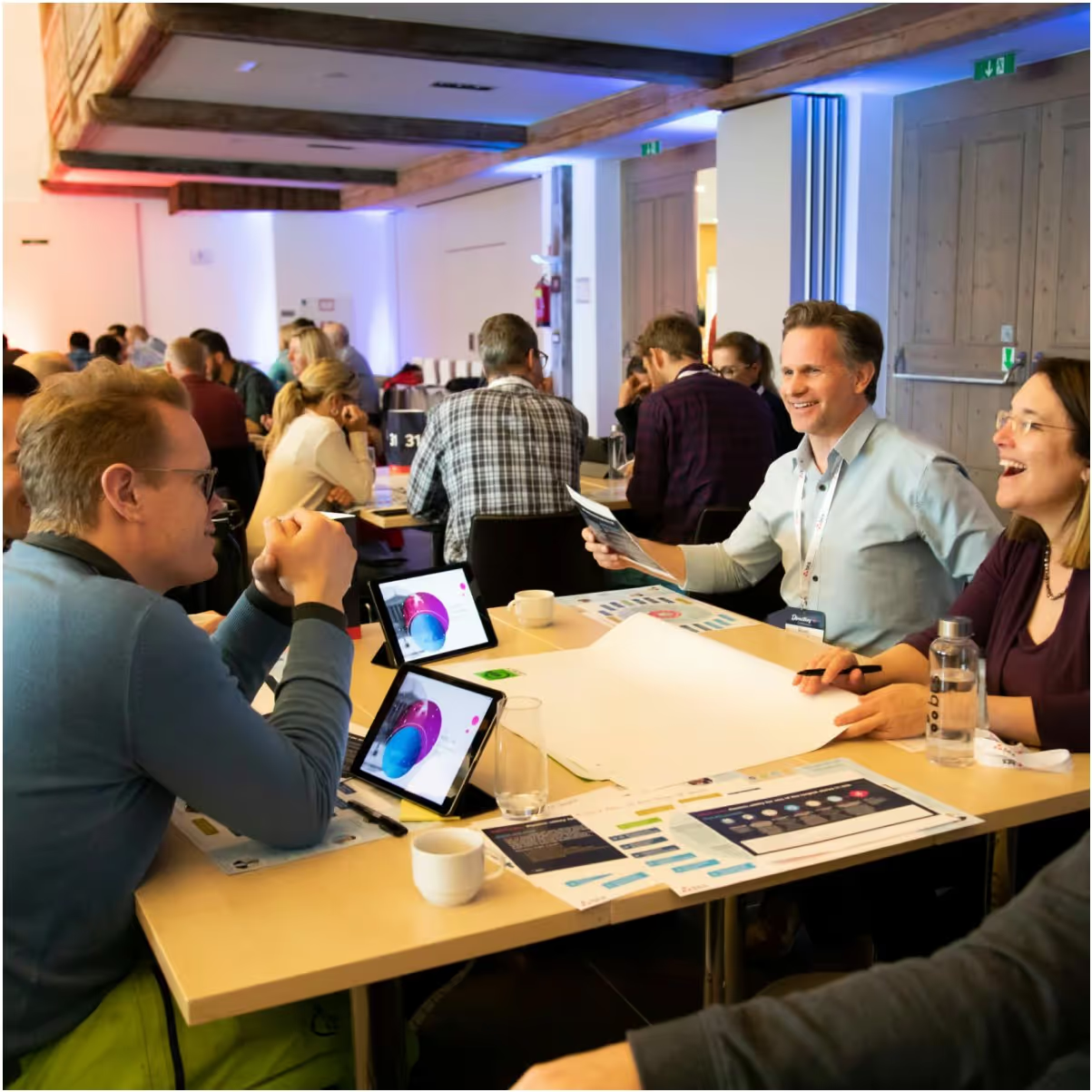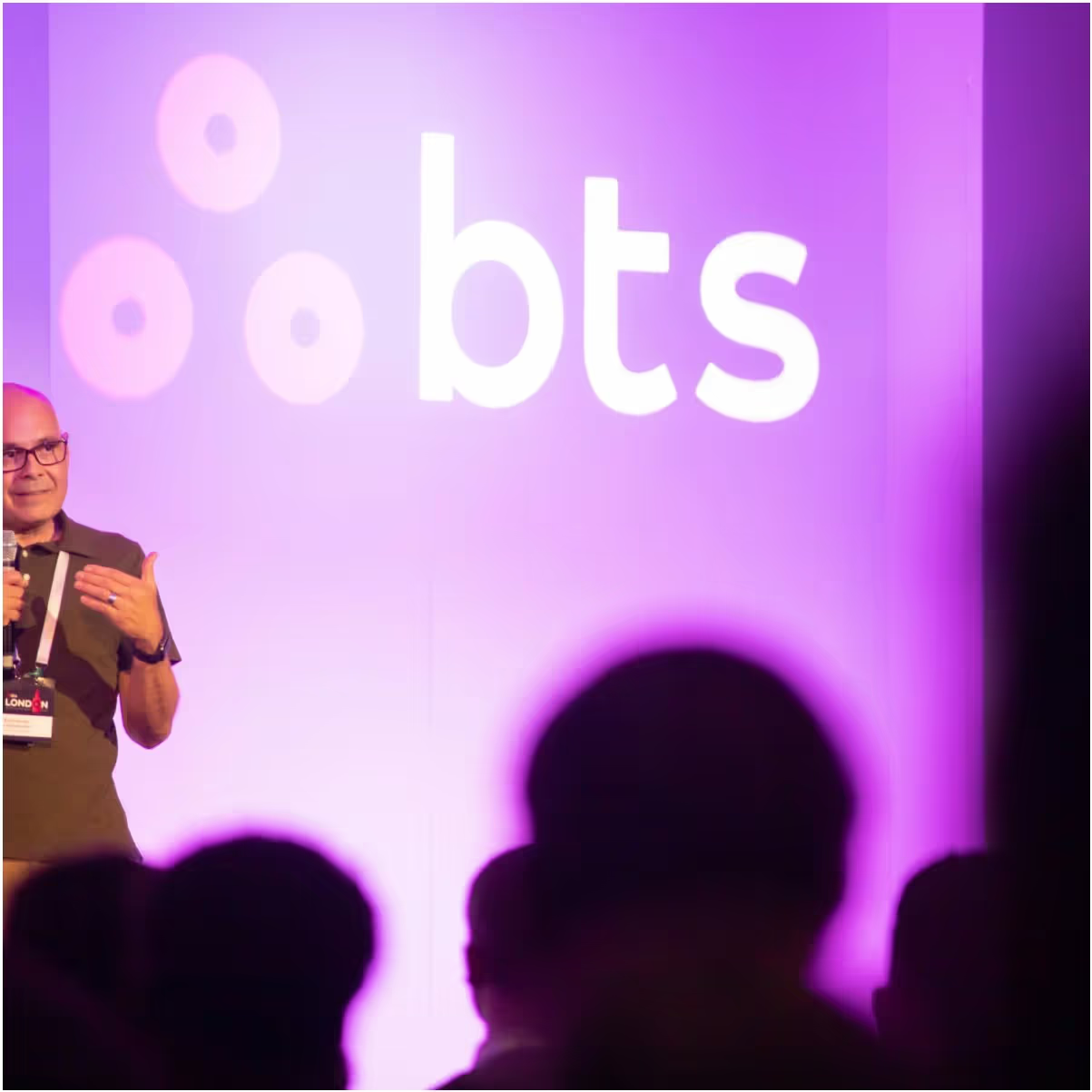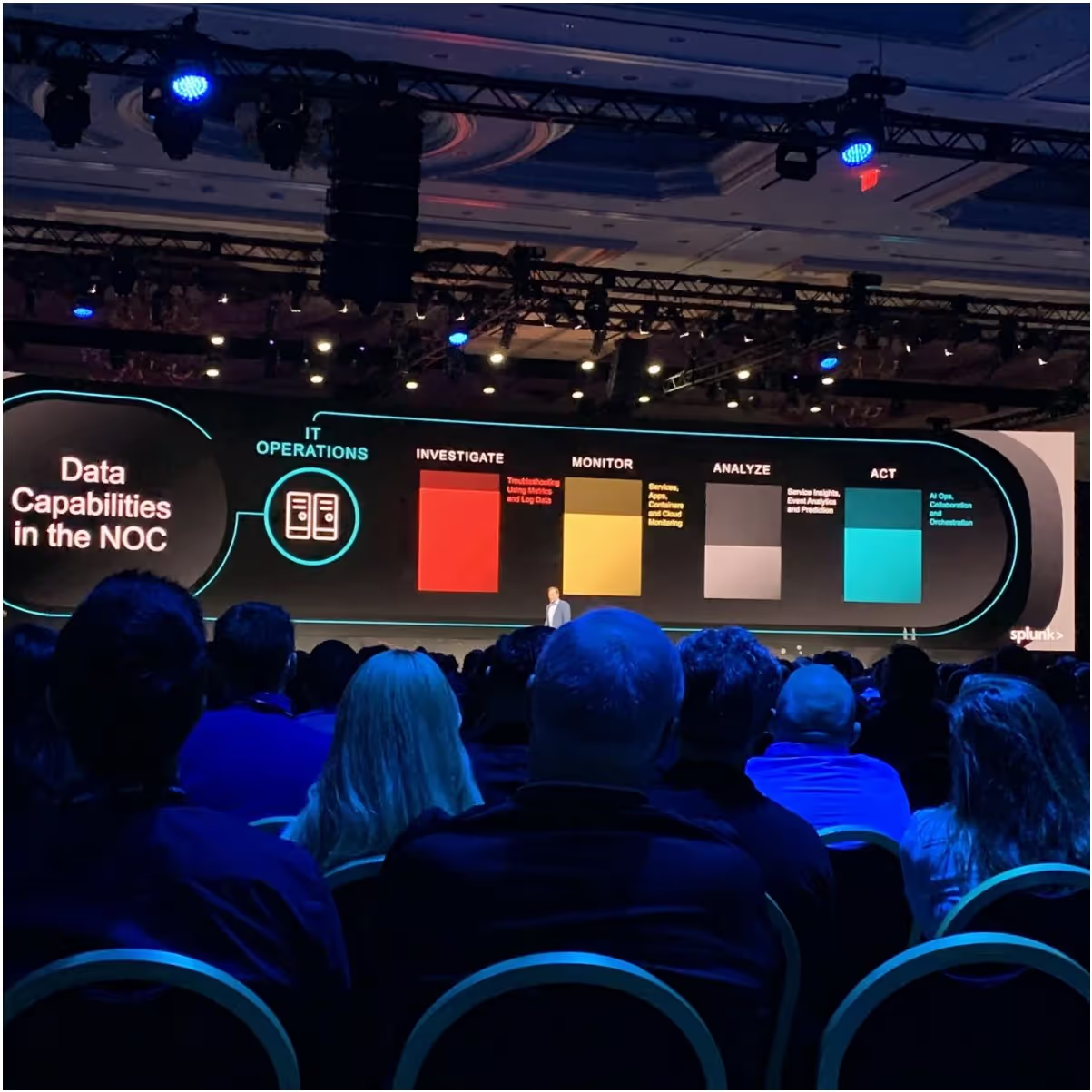Commercial Kickoffs, Meetings, & Summits
Bringing your teams together means more now than ever before.Elevate those moments with powerful experiences.

Experience the BTS difference
We offer a unique opportunity to deliver custom engagements through powerful experiences that align and inspire your people.
We follow mindful design principles during the co-creation process with your team to drive purpose, ownership, reflection, and intention, bringing more value to attendees and your organization.
- Strategic meetings may include: quarterly meetings, leadership alignment meetings, strategy development sessions, and more.
- Sales Kickoffs may include: initiative rollouts, beginning or year-end meetings, product launches, and more.
- Other large scale events may include: team building meetings, business unit specific events, regional events, company retreats, and more.
I need help designing and preparing impactful experiences for my event
I need help developing the main stage and in-room content for my event to bring my event to life
I need help managing logistics of a virtual event
I need to quickly align my organization, leaders, or team around our goals for the future
I need to generate energy, engagement, and focus for our people during a challenging time for my organization, business unit, or team(s)
I need to catalyze change and/or transformation in my organization with a large event
Program Details
Program Options
How we can support you and your teams
Event design advisory
A partner who will help you plan and guide
the execution of your event. Services include but are not limited to alignment of leaders on themes, outcomes and 'red thread, event structure, and speaker selection/preparation
Experience development & facilitation
BTS can support you with the creation of
mainstage presentations, breakout room design (i.e., simulations & conversations), and event emcee & facilitation. This includes in-person, virtual, or hybrid events
Content development & messageing
We can work with you to leverage the broader BTS content library and upskill your audience with proven capability-building exercises that look, feel, and sound like your organization.
12 reasons why commercial kickoffs, events, and summits might be right for you
Initiative rollouts
Product launches
Year-end meetings
Communicating new goals
Team building / Networking
Defining and driving culture
Integrating aqcuired companies
Introducing new leadership
Overcoming difficult times as a team
Personal and professional development
Connecting teams across functions
Celebrating




We help you with events in service of your organization. Embedding strategy and change at scale requires a deliberate focus on four critical elements.
Celebration
Motivation and excitement to carry forward

Alignment
Ensure your entire commercial team shares a common language and goal

Provocation
Lay out a vision for the future and inspire change leaders

Activation
Give teams the tools and education to excecute

How we make this all about your people and your culture
01
Purpose
It is the connective tissue, the story, that brings the entire experience together – enabling individuals to leverage their strengths to drive business outcomes.
02
Ownership
It is about creating opportunities for individuals to workshop concepts and ideas to empower and activate them – authoring is ownership.
03
Intentionality
It is about the practical and meaningful experiments individuals want to take to in the field – driving execution.
04
Reflection
It is the intentional space created for individuals to make sense of each experience and how it connects to purpose – making strategy personal.
Lifecycle
We’ve historically worked with a diverse set of clients who have used these kickoffs, meetings, and summits for different reasons depending on where their organization is in its lifecycle. Hover to explore Stage of the company lifecycle and the events that typically match their objectives
Latest Content

Traditionally, Sales Kick-Offs (SKOs) were large, centralized gatherings, designed to align teams, spark momentum, and roll out the company’s go-to-market strategy. But as global businesses expanded, that one-size-fits-all approach began to show its limits.
Even before 2025, forward-thinking companies were experimenting with more localized formats to meet rising complexity and regional nuance. As international operations expanded, centralized SKOs began to strain under the weight of market variability, logistical challenges, and cultural differences. Regional activations emerged as a way to make strategy more relevant, and more actionable, at the local level.
Then came COVID-19. Travel restrictions, distributed teams, and new ways of working forced companies to reconsider the value, and feasibility, of large-scale gatherings. Virtual and regional alternatives emerged not just as stopgaps, but as smarter, faster, more focused activations.
That shift planted the seeds for what’s now taking hold: a hybrid model, where flagship events are amplified, not replaced, by a network of hyper-local strategy activations.
Why hyper-local SKOs have gained traction in 2025
Tighter budgets, tariff volatility, region-specific complexity, and faster-moving markets have made the traditional SKO model harder to justify, at least for now. But what’s emerging isn’t a downgrade. It’s a high-impact alternative built for today’s realities.
Hyper-local SKOs offer:
- Budget-conscious impact: Less spent on travel, more invested in enablement.
- Regional relevance: Local markets demand tailored approaches.
- Faster execution: Smaller events mean shorter planning cycles and more agility.
- Stronger engagement: Intimate settings foster real dialogue, trust, and retention.
Done right, hyper-local SKOs deliver sharper alignment, deeper enablement, and faster activation, without the logistical drag.
But this approach only works when it’s connected to something bigger:
- A clear, unifying story
- A strategy that flexes by region
- Tools and experiences that build competence, not just motivation
They’re not replacing the flagship event, they’re extending its reach, bringing strategy to life where performance happens in the field.
What to consider if you’re going local in 2026
- Start with a unified strategy
Without a cohesive message, fragmentation becomes a real risk. That’s why leading companies align early on messaging, strategic pillars, and storylines, then empower regional leaders to bring them to life in context.
Centralized intent, decentralized delivery. That’s the sweet spot. - Use simulation and AI-enabled practice to scale what matters
Smaller doesn’t mean shallower. Digital tools, like AI-powered practice platforms and immersive simulations, let teams stress-test decisions, sharpen skills, and internalize strategy.
Instead of hearing strategy, reps experience it and leave ready to act. - Cut costs, without cutting connection
The savings from reduced travel and venue spend are real, but the return comes from reinvesting in high-value enablement: stronger coaching, sharper content, localized insights, and sustained follow-through.
Be thoughtful about how you redirect your budget. Spend to increase the outcome you desire.
- Match the way your teams actually sell
Modern GTM teams flex by region, segment, and product line. Hyper-local SKOs let teams focus on what’s actually happening in their markets.
It’s not just about relevance, it’s about reps feeling seen and set up to win. - Create space for meaningful dialogue
Large SKOs can default to performance over participation. Local formats flip the script. Smaller rooms enable deeper conversations and real-time alignment.
Candor goes up. Trust goes up. Impact goes up. - Move faster, stay closer to the market
Planning a traditional SKO can take six months or more. In a world where pricing shifts monthly and competition evolves weekly, that delay is a liability.
Local events can launch quickly and adjust mid-stream, by design. - It’s not a replacement. It’s a complement.
The flagship SKO still has value, especially to launch a new strategy or bring global teams together. But leading organizations are building a drumbeat of activation through local SKOs that reinforce, tailor, and sustain that initial momentum.
Think about the tradeoffs and choose a flagship SKO versus localized experience based on the desired goal of the event.
Understand the risks and how to avoid them
Hyper-local SKOs bring opportunity, but also potential pitfalls if not well-integrated. Key risks include:
- Fragmentation of message and priorities
Without a strong central narrative, messaging drifts, and alignment erodes. - Uneven quality and experience
When local teams aren’t equally equipped, outcomes vary. Some teams leave inspired. Others don’t. - Loss of cross-regional connection
Flagship SKOs build culture through shared experience. Without intentional connection, silos can deepen. - Underinvestment in enablement
If companies view local SKOs purely as cost-saving, they risk missing the moment to truly invest in seller capability. - Leadership misalignment
If local and global leaders aren’t working from the same playbook, sellers get mixed messages, and lose confidence.
How to mitigate these risks:
- Anchor every SKO to a common strategic narrative
- Equip regional leaders with tools, training, and facilitation support
- Invest in shared enablement assets like simulations and AI tools
- Create cross-regional touchpoints to build culture and community
- Track impact and reinforce key messages over time
Finding new ways to perform and adapt
In a time of uncertainty, the best sales organizations aren’t pulling back on alignment, they’re finding new ways to deliver it.
Hyper-local SKOs offer a strategic evolution: reducing spend, increasing relevance, and accelerating execution.
It’s not just a budget decision.
It’s a better way to make what matters go further.
The question isn’t “What can we do with less?”
It’s “How do we get more out of every moment?”

In 2025, sales organizations are navigating more than just competitive landscapes. They’re contending with intensifying trade tensions, evolving geopolitical alliances, and the cascading effects of global tariffs. These forces aren’t abstract, they’re showing up daily in pricing pressure, delayed shipments, shifting forecasts, and customer churn. And they’re transforming how companies approach go-to-market strategy, starting with how they design and deliver their Sales Kick-Offs (SKOs).
Tariffs are no longer edge-case scenarios. They’re sending ripple effects across every link in the value chain. Sales teams are contending with pricing instability as supplier costs swing unexpectedly. Delivery timelines are harder to pin down. Customers are pushing back on cost hikes or walking away altogether. And forecasting? It’s become a moving target. What was once considered a background risk is now a central variable in sales planning.
In this climate of constant flux, SKOs are evolving from motivational moments into serious strategic platforms. Several themes are rising to the surface:
1. Redefining “adaptability” in sales strategy
Tariffs have amplified economic turbulence. With global cost structures in near-constant motion, organizations are being forced to sharpen how, and how fast, they respond. While “agility” has been a staple of business language since COVID-19, today’s landscape demands something deeper: adaptability built on scenario planning, data fluency, and customer-centered pivots.
Sales teams are being asked to do more than react. They’re adjusting pricing mid-cycle, sourcing new suppliers, and rethinking product priorities based on margin impact or availability. SKOs need to reflect this reality. It’s not just about preparing for change—it’s about practicing for it. Teams need exposure to the messiness of mid-quarter shifts, trade-offs across functions, and pressure-filled decisions that can’t wait.
2. Flexible pricing models are pushing teams to focus on customer value
As tariff-related costs climb, many companies are left with little choice but to raise prices. But doing so without a strong value narrative is risky, especially in a market shaped by caution, cost sensitivity, and competitive noise.
Sellers can’t afford to lead with price. They need to lead with relevance. That means helping customers connect the dots between solutions and the outcomes that matter to them—faster ROI, mitigated risk, and sustained performance. The more the landscape shifts, the more essential it becomes to differentiate through clarity and confidence, not discounts.
3. Relationship-building, referrals, and longer sales cycles
In unpredictable environments, trust becomes a competitive advantage. Tariffs introduce new friction—delivery delays, price changes, procurement constraints—that sellers must help customers navigate. As buyers face more internal scrutiny, decisions slow down. Sales cycles stretch. Consensus is harder to build.
All of this puts relationship quality front and center. Sellers who understand their customer’s world, anticipate challenges, and offer real partnership—not just pitches—are the ones who earn the right to stay in the conversation. Advisory behaviors and referral networks matter more than ever. Investing in long-term trust has become a short-term differentiator.
4. Shaking things up with cross-functional insights
The effects of tariffs aren’t siloed. They ripple through procurement, finance, operations, and strategy. Sales teams without visibility into those pressures risk overpromising or missing opportunities for smarter collaboration.
That’s why more organizations are bringing cross-functional voices into the SKO. Procurement leaders are spotlighting sourcing constraints. Finance is unpacking cost structures and trade-offs. Operations is clarifying where flexibility exists and where it doesn’t. These perspectives help sellers see the system they operate within and bridge the gaps that often slow down execution—from misaligned incentives to regional friction.
5. Leveraging AI and data to support shifting targets for frontline sellers
In a tariff-impacted world, data is no longer a nice-to-have. It’s a real-time edge. As market signals shift faster than humans alone can track, AI-powered tools and predictive analytics help surface patterns, sharpen messaging, and guide better decisions.
Forward-looking companies are embedding AI into the SKO itself. Tools like BTS’s Verity give reps the ability to practice, iterate, and refine in real time, coaching them through tough conversations, pricing trade-offs, and shifting buyer behavior. It’s not about replacing reps. It’s about expanding their ability to adapt, stay sharp, and lead confidently through constant change.
6. Preparing for longer sales cycles and negotiations
As cost pressures rise, customers are taking longer to commit. Deals are dragging. More stakeholders are weighing in. Pricing discussions are stretching further than before.
SKOs are a chance to help teams get ready for that reality. Sellers need to build fluency in managing drawn-out conversations, navigating objections, and reinforcing value over time. Practicing those skills now ensures they can show up with confidence and consistency, especially when the path to close is slower and more complex than expected.
Rethinking your SKOs for shifting ground
Tariffs aren’t a temporary disruption—they’re part of a broader pattern of global instability that sales organizations must plan around. The question isn’t how to avoid the turbulence. It’s how to lead through it.
That’s what the best SKOs are doing in 2025 and into 2026: grounding teams in the real conditions they’re facing, building strategic muscle, and creating alignment across the business. It’s not about hype. It’s about capability.
Done right, your SKO becomes more than a kickoff. It becomes a catalyst—one that equips your team to win on uncertain ground.

In a world where TikTok-length attention spans are the rule not the exception, executing a successful commercial kickoff, meeting, or summit is more challenging now than ever before.
People’s short attention spans mean that during a typical commercial kickoff, engagement levels plummet. Hours of back-to-back meetings with no actionable takeaways are not only boring for employees, but they also don’t make a difference for your business.
So – how do you make the most of your time together? Get creative. By injecting a little creativity into your meeting format, you’ll eliminate the monotony and give your team an experience that will accelerate results, foster innovation, and keep their TikTok brains engaged the whole time. Whether your next commercial kickoff is in-person, remote, or a hybrid, here are four moves to ensure it is a success.
- Be savvy with your investment. When organizing a commercial kickoff, it's tempting to prioritize hiring a high-profile speaker – but getting a big shot on stage isn’t what will really engage your people. Go beyond the surface-level and consider the core elements that make an event memorable: Are you investing in quality content and impactful messaging? Are you allocating resources to find a remarkable venue? Are you curating immersive experiences that will go beyond the event? These factors are all more important than booking a big name. By focusing on investments that drive value, you’ll ensure that you're maximizing the potential of your kickoff and providing attendees with an unforgettable experience.
- Don’t pack your agenda so tightly that there’s no space for reflection. We’ve all had the experience: bouncing between speeches and roundtables and workshops—taking voluminous notes—and then returning to our everyday work with no idea how to apply what we learned. When building your kickoff’s agenda, schedule ample time for thoughts and reflection. That’s important during in-person events. Even more so for virtual gatherings. A 90-minute presentation followed by a 15-minute break? That won’t cut it. Time breaks based on how much people can absorb before they get overwhelmed and tune out.
- Make it a two-way conversation. If you position your people as passive recipients of wisdom from the top, you’ll quickly lose their attention. Eventually, you’ll lose them. Build in opportunities for everyone to share their insights and ideas and help set the direction for the company. The benefit is twofold – people will get to share their ideas with leadership and leadership may be able to uncover some even better insights.
- Be conscious about building in networking opportunities. In-person, individuals left to mingle without a purpose tend to coalesce into clumps of co-workers they work with every day. In a virtual room, the conversation will be dominated by a few extroverts, leaving everyone else feeling unheard. This does not promote engagement or inclusivity. Instead, set intentional opportunities to connect. Build in time for “speed dating” where people meet each other for a rapid-fire five minutes of conversation or create small break out groups of intentionally diverse teams to spend 30 minutes together. Whether virtual or in person, connection is everything and it’s your job to be intentional about making it happen.
Hosting engaging commercial kickoffs in today’s TikTok world will never be easy. However, by being creative about how you craft the experience, you’ll run an engaging event that will inspire and equip your team to be successful. Whether you’re launching a new product, kicking off a new quarter, or setting sales goals that will help your organization reach its next billion-dollar target, leverage these tips to help your commercial team kick things off with the right foot forward.

Ready to start a conversation?
Every successful transformation begins with a meaningful conversation. Connect with us to explore how BTS can partner with you to make the shift.















